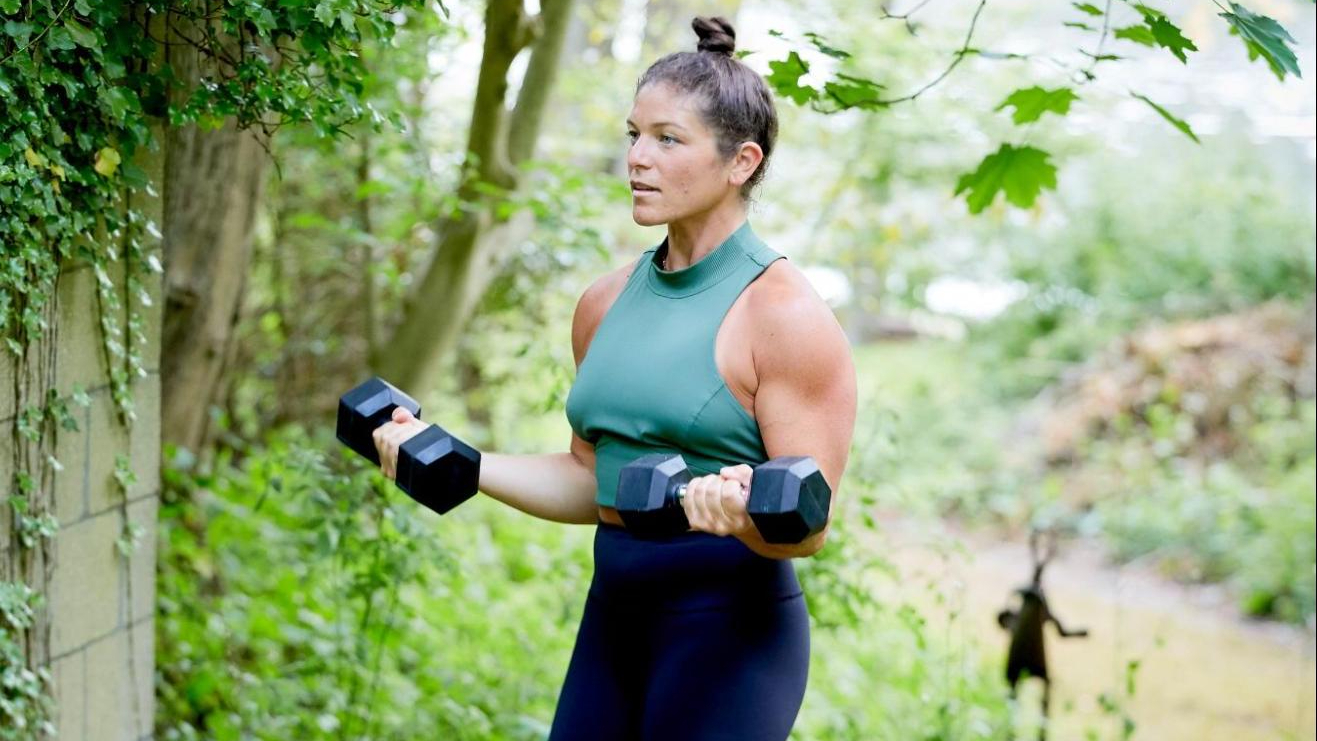Compound vs isolation exercises for building muscle
We asked a personal trainer to explain the pros and cons of compound and isolation exercises for building strength


Whether you're new to strength training or looking to shake up your routine, you'll have a choice; compound vs isolation exercises. These two training techniques have different benefits, and there'll be times you want to choose one over the other.
Isolation exercises like biceps curls work specific muscles, while compound exercises engage several muscles simultaneously for a time-efficient workout. But that doesn't mean either is necessarily better for you to hit your fitness goals.
There'll be times when you want to pick up a set of the best adjustable dumbbells and focus on a single muscle group, but if you're tight on time, you might switch to a kettlebell to target all the major muscles in your body and boost your metabolism.
We spoke to certified personal trainer Dianna Falzarano to find out more about the differences between compound and isolation exercises, which is best for building muscle, and the right type of training you need to target fat and lose weight.

Dianna Falzarano is an NCSF-certified personal trainer and a Certified Functional Strength Coach (CFSC). She owns the virtual studio and personal training service Dynamic Fitness LI. With over eight years of experience in the fitness industry, Dianna is also certified in pre and postnatal performance training, barre, TRX, and Pilates.
What is the difference between compound vs isolation exercises?
As the name describes, isolation exercises isolate or work one muscle group at a time. In contrast, compound exercises involve movements that require multiple joints and muscle groups working together to perform the exercise.
"Examples of isolation exercises are bicep curls, cable triceps pushdowns, and the lying down hamstring curl," shares Falzarano. "Examples of compound exercises are squats, deadlifts, and the bench press."
In terms of the type of exercise equipment used for compound vs isolation exercises, Falzarano says there are no right or wrong kinds of equipment or rules regarding how to use the equipment for these types of workouts.
Start your week with achievable workout ideas, health tips and wellbeing advice in your inbox.
However, there are often best practices or common trends regarding what type of exercise equipment lends itself well to an isolation or compound exercise. "Each piece of equipment has an important place in any workout program," says Falzarano.
"Resistance bands are great during a warm-up. Weight machines such as the leg press, prone hamstring curl, and cable machine are going to be beneficial for isolation exercises. Dumbbells and kettlebells should be your go-to for compound lifts to build strength and increase muscle."
Are compound or isolation exercises better for building muscle?

Falzarano says that you can use compound and isolation exercises to build muscle. Whether compound or isolation exercises are better for building muscle or achieving your fitness goals largely depends on the target and how you plan your workouts.
"[Many programs] will have a combination of both. If you're looking to build up one specific area of the body, then isolation exercises are the better choice," suggests Falzarano. "However, for the general population, compound exercises are more beneficial. Essentially compound exercises will get you more bang for your buck."
Furthermore, Falzarano believes that the benefit of performing compound exercises to build muscle is that it is easier to safely and incrementally overload your muscles since multiple muscle groups work together.
"Compound exercises use multiple muscle groups simultaneously, so you can progressively overload faster than isolation exercises," she explains. "This means you can increase the weight you're lifting at a quicker pace, helping to build strength and increase muscle mass."
Are compound or isolation exercises best for beginners?
Falzarano says that in most cases, beginners should generally start with compound exercises. This could sound counterintuitive because compound exercises involve multiple muscle groups simultaneously and are often more technique driven than isolation exercises.
But this is primarily because compound exercises are more efficient and give you a "bigger bang for your buck," allowing you to get results in a shorter timeframe. And compound exercises include functional movements you use for everyday tasks like carrying groceries.
Moreover, even if you are a beginner, your body likely has some muscle memory or familiarity with general movement patterns of compound exercises since they often replicate athletic or daily life motions such as squatting, pressing, and pulling.
"Once my clients can nail down their form in compound lifts, I begin to incorporate isolation exercises to target specific muscle groups," shares Falzarano.
"Though, if a beginner has injuries or is having difficulty activating a certain muscle group during an exercise, I tend to work in an isolation exercise before the compound lift. This way, the right muscle group is used to complete the exercise effectively."
Should you do compound or isolation exercises for weight loss?

If your primary goal is weight loss, your workout routine should focus on compound exercises. As Falzarano explains, "Compound exercises will be more beneficial for weight loss."
"You'll be recruiting more than one muscle group at a time which will increase your endurance and heart rate and essentially burn more calories."
This is why many of the best exercises for weight loss are compound moves, often arranged into a high-intensity resistance training (HIRT) routine, where you train intensely for short bursts with minimal rests.
This works your whole body, raises your heart rate so you burn more energy than during a steady-paced isolation exercise routine, and boosts your metabolism for all-day fat-burning results.
What are the disadvantages of isolation exercises?

Isolation exercises are an excellent way to target specific muscle groups, but the limited nature of these moves has a few disadvantages. "Since you are working one muscle at a time, it can be harder to increase the weight you're using," explains Falzarano.
"And in terms of weight loss, you can't spot [reduce] the area in which you want to make smaller or lose weight. For example, isolated abdominal exercises do not necessarily lead to a flatter stomach, but compound exercises can simultaneously work your legs, core, and arms."
Falzarano generally suggests increasing the number of repetitions and using lower weights than compound exercises to increase the effectiveness of isolation exercises. This will also build the mind-muscle connection, helping you perfect your technique to get the most from your training.
What are the disadvantages of compound exercises?
While compound exercises are generally more efficient, there are still some disadvantages to performing compound exercises compared with isolation exercises.
"Since you're using multiple muscle groups during a compound lift, it can be harder to target a specific muscle that isn't as strong as the others," cautions Falzarano.
"For example, if a client performs a deadlift with dumbbells and feels this exercise in their low back instead of their glutes, I will sometimes utilize an isolation exercise to fire up the target muscle before the deadlift."
If you're new to compound activities, learning how to do a push-up is a great place to start. This bodyweight exercise engages several muscles, allowing you to experience full-body movements before progressing to higher-load activities like kettlebell swings.
Compound vs isolation exercises: which should you use?
When starting a strength training program, one of the first factors to consider is the type of exercise you want to perform. In general, both compound and isolation exercises serve a purpose.
"A well-rounded program should have a combination of the two. The challenge can sometimes be knowing when to incorporate each type of exercise, how many sets and reps to perform, and how much weight to use in each lift," explains Falzarano.
"This is why it's important to learn from a certified trainer to help you lift confidently and safely throughout your fitness journey." Alternatively, consider using one of the best workout apps for guided sessions tailored to your goals.
Amber Sayer is a Fitness, Nutrition, and Wellness Writer and Editor, and contributes to several fitness, health, and running websites and publications. She holds two Masters Degrees—one in Exercise Science and one in Prosthetics and Orthotics. As a Certified Personal Trainer and running coach for 12 years, Amber enjoys staying active and helping others do so as well. In her free time, Amber likes running, cycling, cooking, spending time outside, and tackling any type of puzzle.
